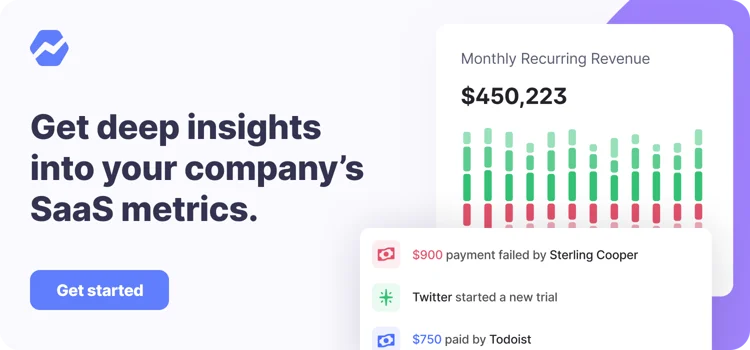Table of Contents

Data enrichment is the process of adding value to your already existing data by providing supplementary information and context. The additional data can be retrieved from another data source within the same organisation or a third-party application altogether.
For example, suppose your app displays a username or a unique identification number. You can easily refer to the details of the end-user, such as their actual name, associated phone number, and email address. This helps sales and customer success teams communicate with users using their real information.
What makes data enrichment so useful is that it gives more insight into the customers you are dealing with. Especially when information is scattered and fragmented, data enrichment plays a key role in producing comprehensive results.
Baremetrics is here to enrich the information you know about your customers. You should sign up for the Baremetrics free trial and start learning about your customers.
All the data your startup needs
Get deep insights into your company’s MRR, churn and other vital metrics for your SaaS business.
Data enrichment for your customers at Baremetrics
At Baremetrics, there are two features that can be used to enrich your customer data.
The Baremetrics Tool People Insights packs your customer profiles with information about your customers. This tool will autofill your customer profiles with their location, real names, and emails. It will also make it easy for you to track every charge, failed payment, and transaction history of your customers.
The Baremetrics Augmentation tool merges your business metrics with external data so you can see more about your customers. For example, it connects the NPS score a customer gave you with that customer’s profile – so you know exactly how satisfied they are when you talk to them next.
You can also correlate the number of times a customer has communicated with support to their NPS score or their churn rate.
How can you get enriched data on your customers?
There are several third-party tools available for Data Enrichment. The important question before opting for any tool is what kind of data are you looking for?
Depending on the type of data you have and your purpose, you will use different tools. For example, if your data is in a spreadsheet, there will be data enrichment tools like Clearbit that can take an input of .csv and return a .csv of fully enriched data.
The trouble with that is how to apply the enriched data when it’s in .csv form. If your data is directly in-app, and you are applying it in-app to improve your customer experience, then you may want to use a tool like Baremetrics that can integrate directly with your customer-experience toolkit.
It also depends on the type of information you are looking for. For example, if you are developing a food delivery software, then the conventional information about gender or marital status does not make a good targeting parameter. Past purchases or geolocations will help you target your customer better.
What kinds of data can enrich your customer profiles?
To get started, let’s look at the different kinds of data you can use to enrich your customer profiles.
1. Identity data
Identity data refers to data about a person’s identity, such as name, phone number, and email. This kind of “user research” identifies what kinds of people are interested in your products and services.
The basic data is usually collected when a user signs up on your website. The alternative way is to use a third-party tool to merge the scattered data across the Internet and make sense of it. For example, pulling emails from public places that match with the name provided.
You can easily collect this kind of data on your own by google searching the information related to the individual you want to enrich. However, on a scale of 100s of people, it becomes extremely time-consuming. If you need to do it on a wide scale, we definitely recommend using a tool to get it done!
2. Socio-economic identifiers
While conventional data pave the way to targeted marketing, it is the socio-economic identifiers such as salary, position, industry, company size, and job title that allow you to really get inside the head of your customer or lead. Being able to identify the area of work someone indirectly affects what you should talk to them about.
For example, if you know your contact is in accounting, you’ll most likely talking to them about the billing and the consumer contracts of your product.
If a free trial earns less than the average salary for a given country, it is unlikely that they will be interested in investing in a premium or a high-end version of your product/service. On the other hand, showcasing a reasonable plan with limited yet exciting features could increase the chances of conversion as money is a limited resource in this scenario.
If someone is from a large company, money will likely not be an issue. Such a prospect is more likely to be interested in locking in a 3-years contract at a low monthly cost.
Knowing about your prospect’s situation is critical in getting the messaging right.
3. Behavioural data
Behavioural data includes information about the customer’s browsing habits, buying habits, and social media activity. Such data helps in assessing a customer’s journey from searching to buying. If we have this information, the targeted communication can then help in more conversions. Eventually, it leads to more profit.
The People’s Insights feature offered by Baremetrics serves as an example for this category. It offers customer-rich profiles which track your customers and knows all of their in-app behaviour.
People Insights keeps track of failed payments and every transaction made through a customer’s profile.
In-app behaviour is extremely important for both sales and customer success. Knowing what your customer is or isn’t doing in-app can lead to better customer care.
4. Qualitative data
Now that we have the basic information and the numbers associated with a customer’s account, it is time to find out what opinions your customers hold. This includes any pre-existing bias, reviews or feedback they might have left on social media accounts regarding your products or any similar product in the market. This gives an insight into what their preferences are and how they actually feel about your product.
Take the skin-care industry for an example. Lately, the field has been growing at an exponential rate with a wide range of companies and tons of products. Qualitative research about your customers, such as preferred key ingredients by a customer within a product, can be helpful when making recommendations. For instance, someone with an oily acne-prone skin would likely go for a salicylic acid-based product rather than, say, a heavy moisturiser designed for dry skin. While machine learning plays a significant role in extracting the sentiments out of a text or review, the results can be significantly improved if the data we’re starting with is good enough in the first place. This is where qualitative data comes into play.
Sign up for the Baremetrics free trial and start seeing more about your customers.
Want to Reduce Your Churn?
Use Baremetrics to measure churn, LTV and other critical business metrics that help them retain more customers. Want to try it for yourself?
A great tool for data enrichment
While there are a number of third-party applications available on the web, Baremetrics is great for enriching data on anyone who is currently using your app. Baremetrics is a business metrics tool that provides 26 metrics for your business evaluation, such as MRR, ARR, LTV, and more. Baremetrics has further features, such as People Insights and Augmentation. With the People’s Insights feature, you can:
1. Customise user segmentation: Separate the customers based on a given condition, such as location or behaviour.
2. Enrich customer profiles: Get notified about your customers’ location, transactions, how active they are, and much more.
3. Handle manual subscriptions: Deleted an instance by accident? You can now add in customers manually, as well as add in customer information manually.
Conclusion
In this post, we covered the basics of data enrichment and how you can get started. We also saw different kinds of data and their role in targeted marketing and customer service. Of course, you don’t need to have all four kinds of data to start with. You just need the most relevant ones.
Data enrichment is a crucial part of one’s business cycle. Missing or unbalanced data leads to biases with machine learning algorithms which can later be fatal to your business decisions. It is therefore important to start with better, clean data in the first place. By investing in quality data, you are ensuring better performance of these black-box algorithms and hence, a better outcome altogether.
With Baremetrics, you are doing more than just adding value to your data. You’re building smart dashboards, control centres, forecasting models, and more. Baremetrics provides Benchmarking tools that let you compare your business within the industry, and Trial Insights improves your conversion rate and track performance.
Sign up for a Baremetrics free trial and start enriching your data today!
be honest
How well do you know your business?
Get deep insights into MRR, churn, LTV and more to grow your business


